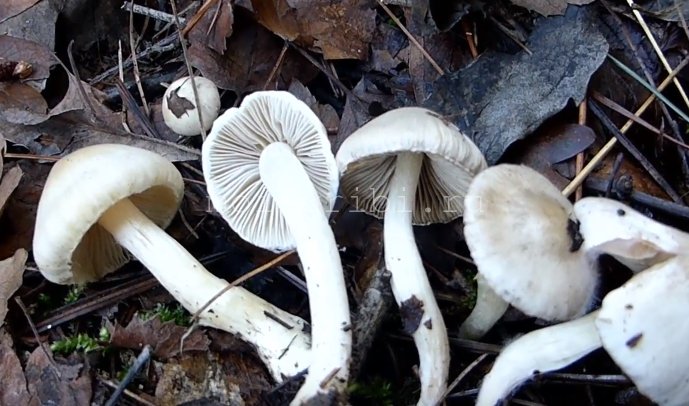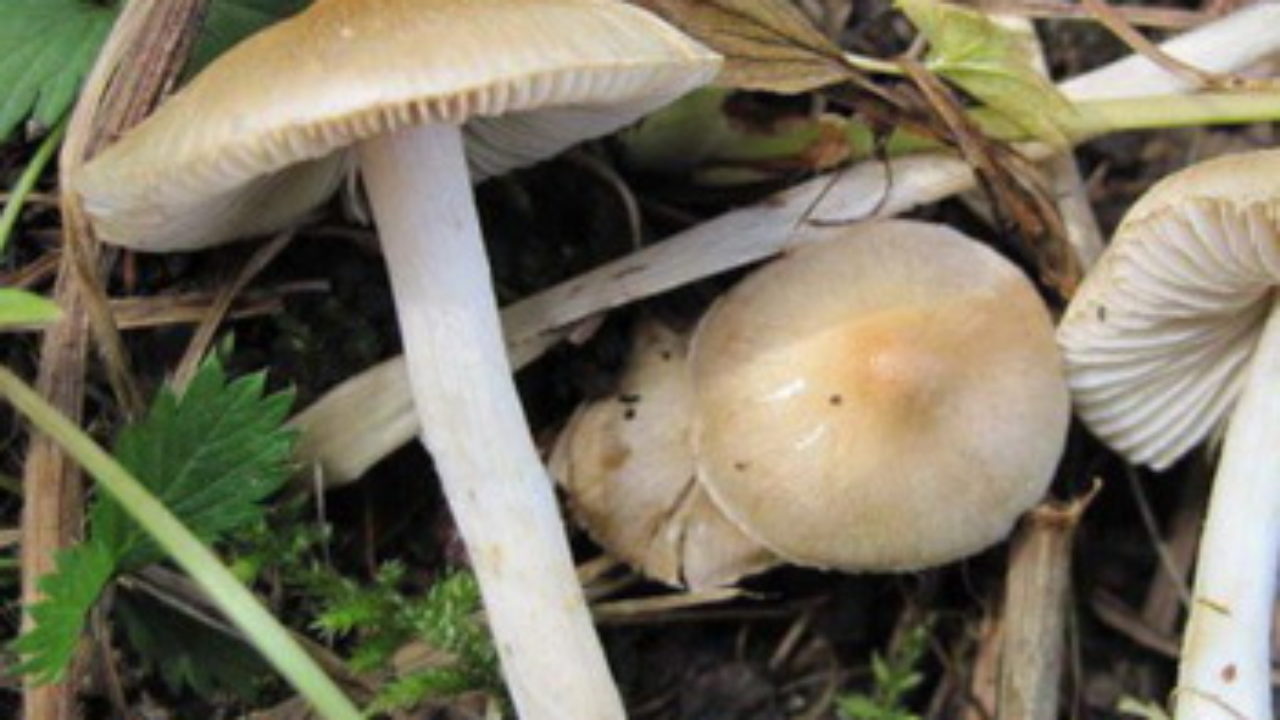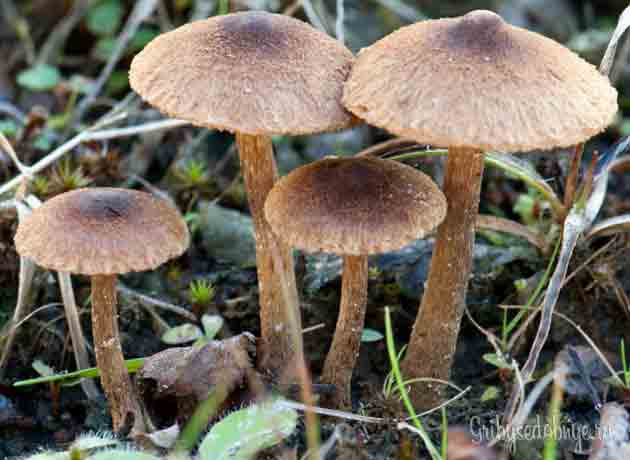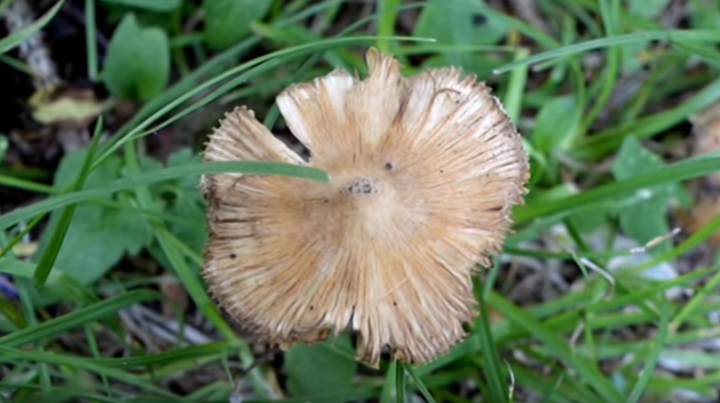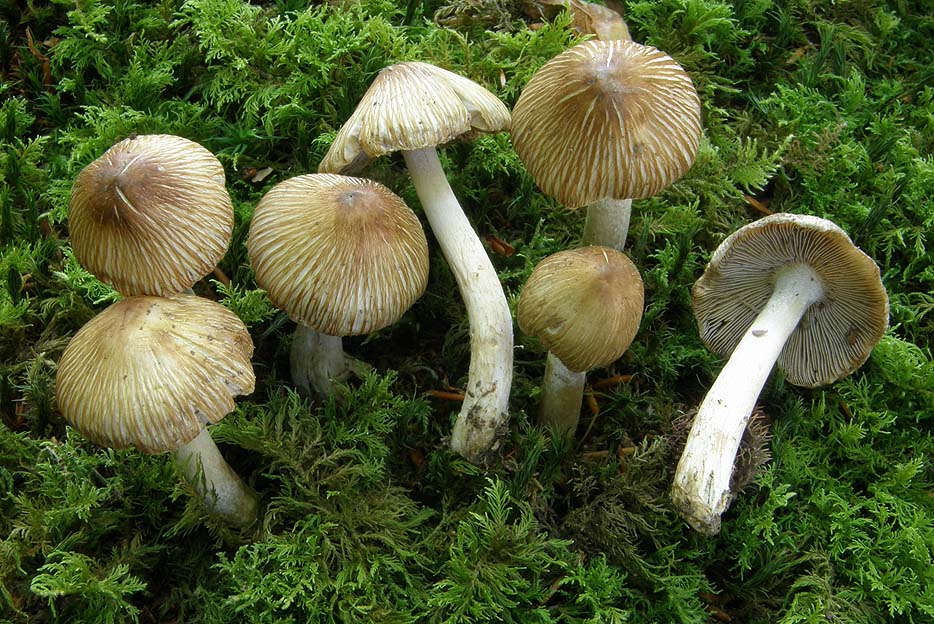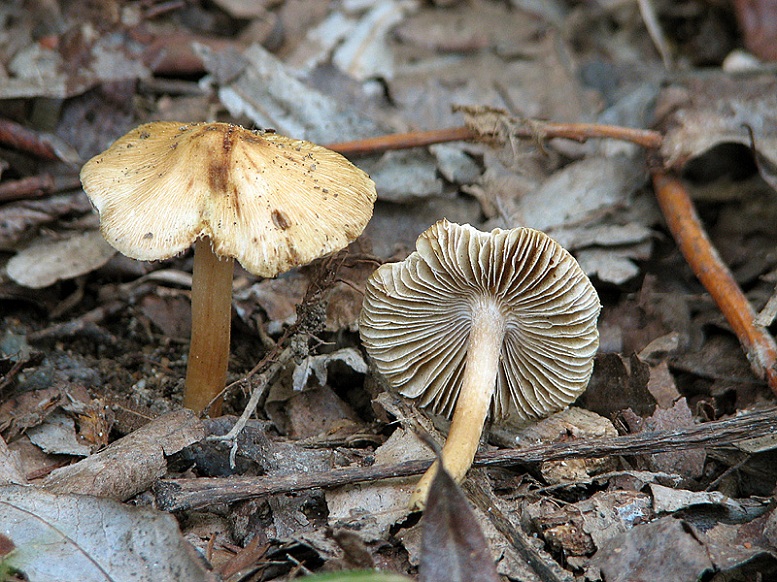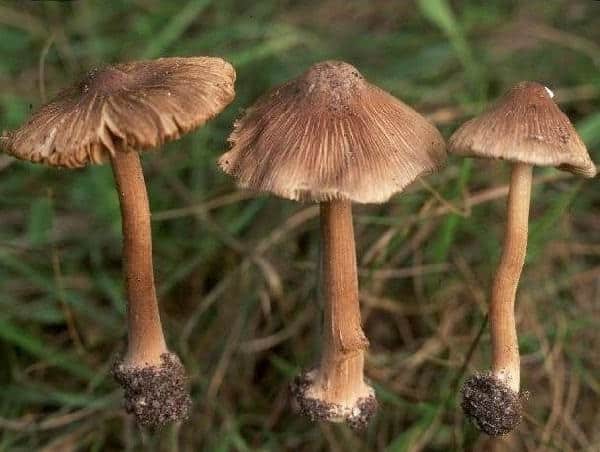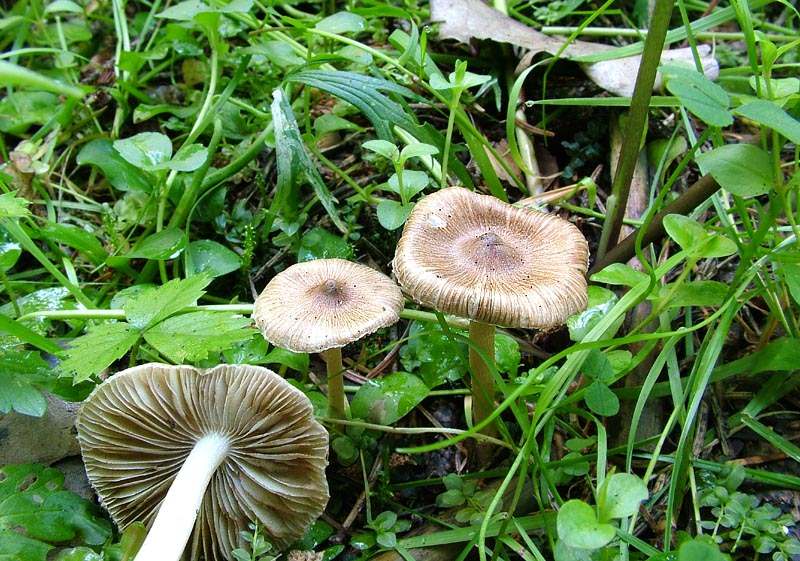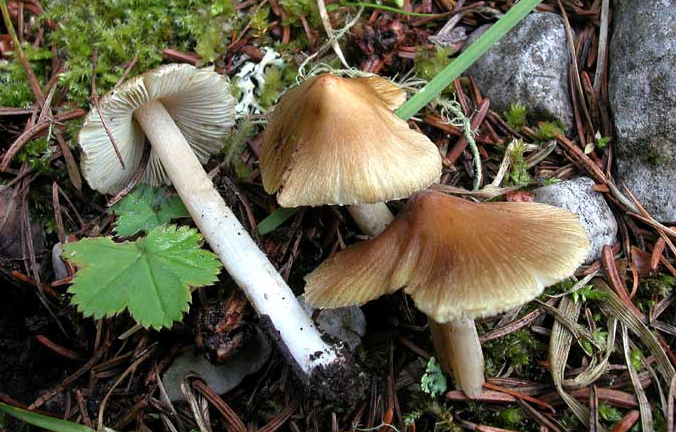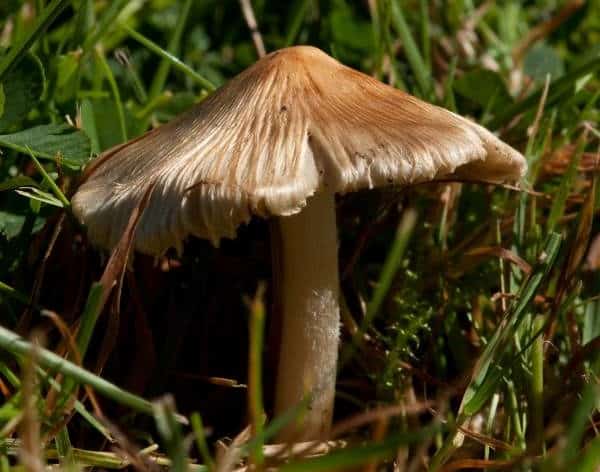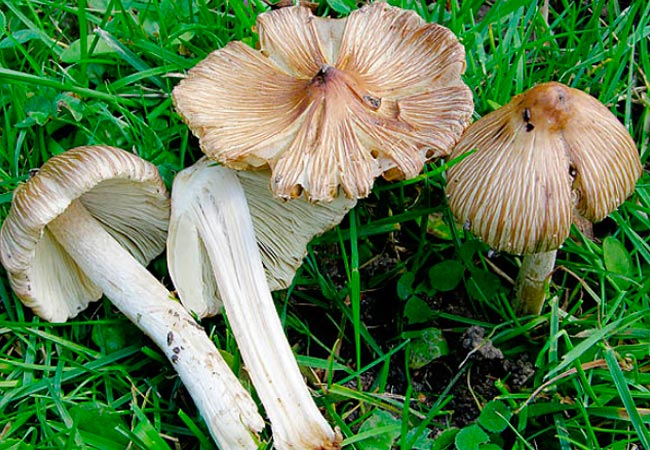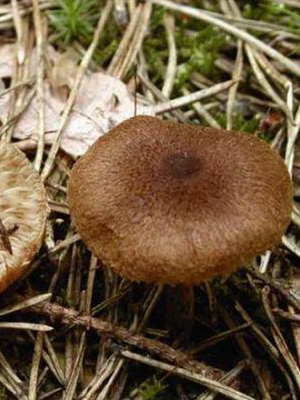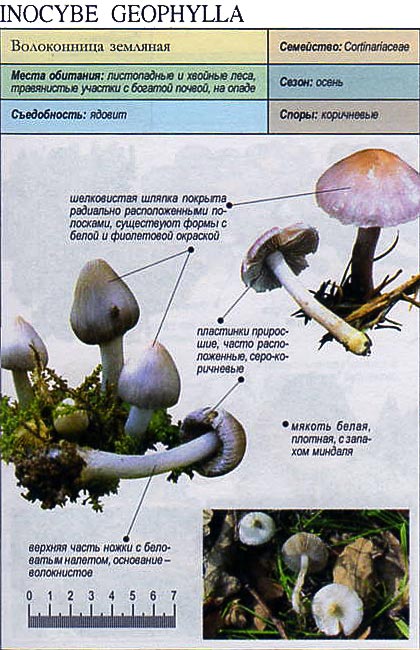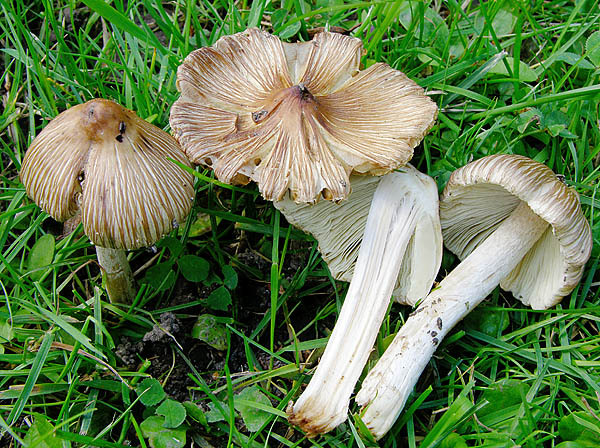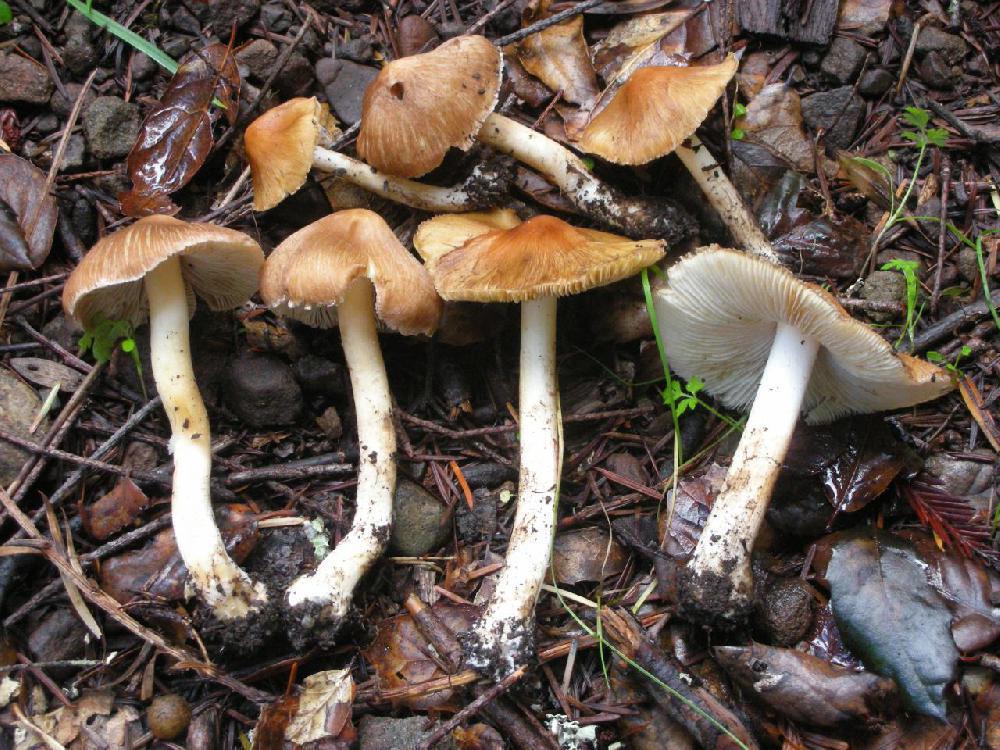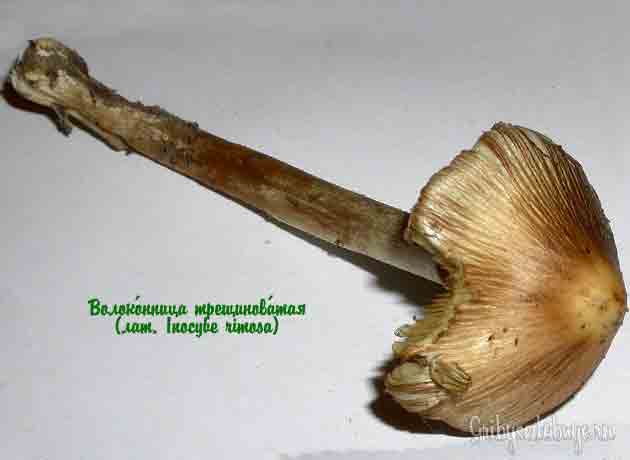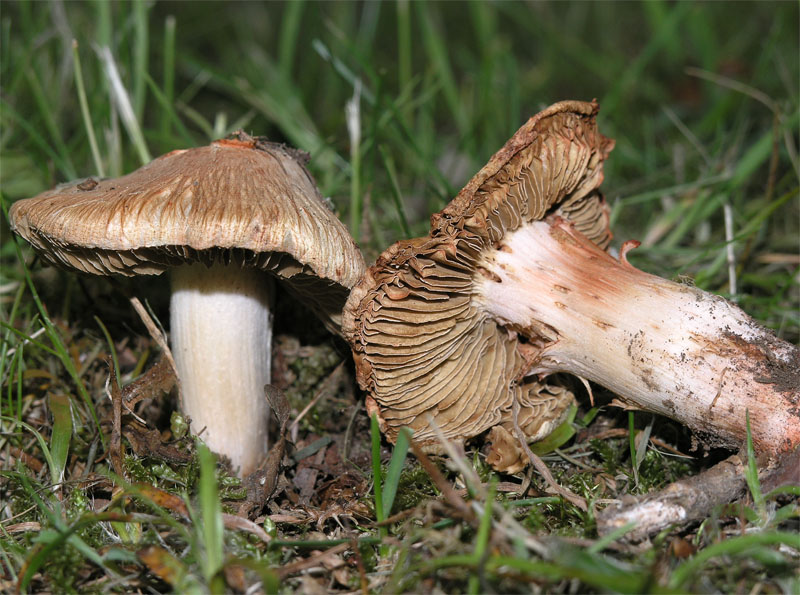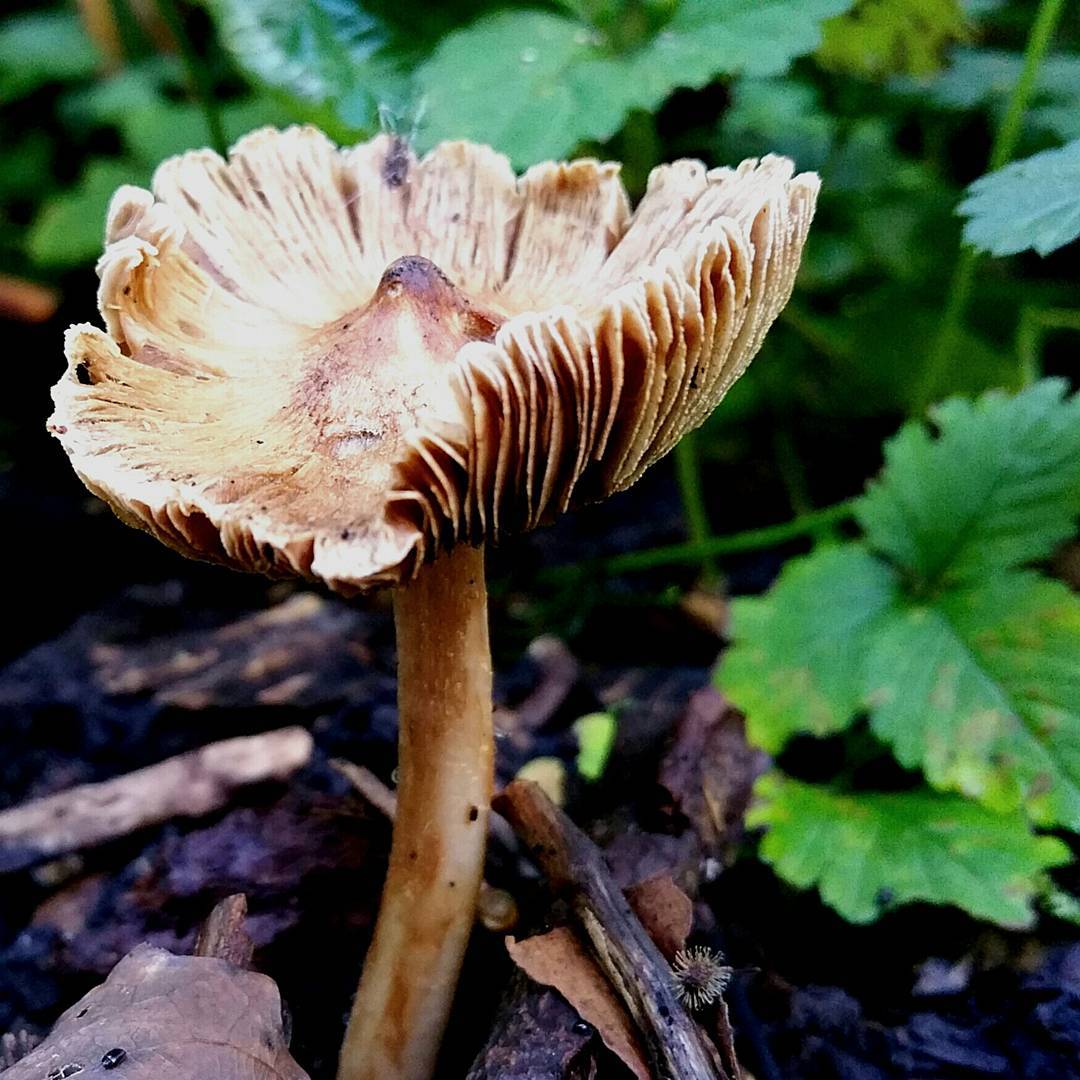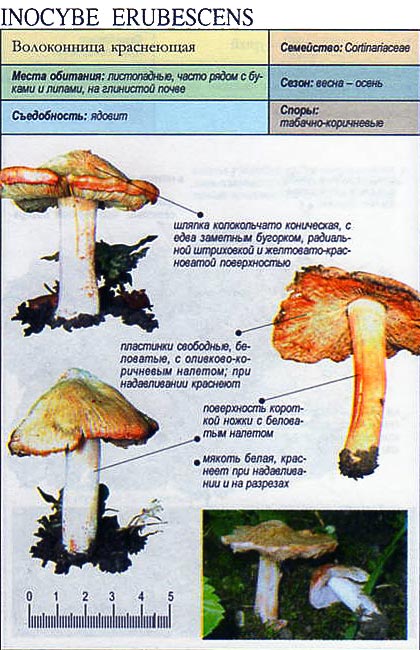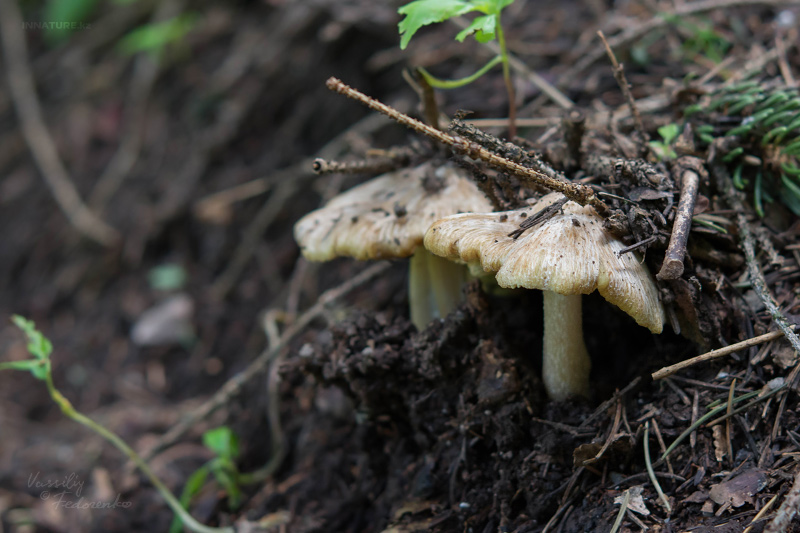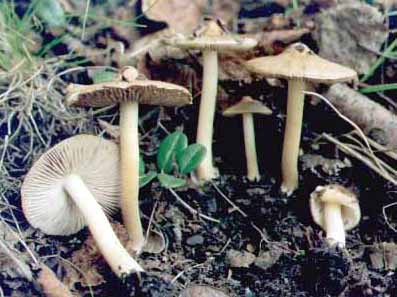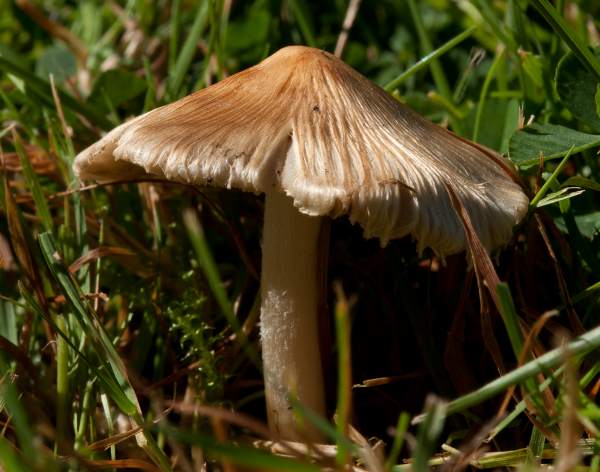Taxonomy
Synonyms
- Agaricus aurivenius Batsch, 1786
- Agaricus curreyi Berk., 1860
- Agaricus fastigiatus Schaeff., 1774
- Agaricus injunctus Britzelm., 1883
- Agaricus perlatus Cooke, 1886
- Agaricus rimosus Bull., 1789: Fr., 1821basionym
- Agaricus schistus Cooke & W.G.Sm., 1886
- Agaricus servatus Britzelm., 1885
- Gymnopus rimosus (Bull.) Gray, 1821
- Inocybe aurivenia (Batsch) Bres., 1930
- Inocybe brunnea Quél., 1880
- Inocybe conica P. Larsen, 1931
- Inocybe curreyi (Berk.) Sacc., 1887
- Inocybe fastigiata (Schaeff.) Quél., 1872
- Inocybe fastigiata f. umbrinella (Bres.) Nespiak, 1990
- Inocybe fastigiata subsp. umbrinella (Bres.) Dermek & J. Veselský, 1977
- Inocybe fastigiata var. umbrinella (Bres.) R. Heim, 1931
- Inocybe holoxantha Grund & D.E. Stuntz, 1981
- Inocybe infracta Velen., 1920
- Inocybe laeta Alessio, 1979
- Inocybe nana F.H. Møller, 1945
- Inocybe obsoleta Romagn., 1958
- Inocybe orbata Malençon, 1970
- Inocybe perlata (Cooke) Sacc., 1887
- Inocybe pseudocookei Métrod ex Bon, 1996
- Inocybe pseudofastigiata Rea, 1927
- Inocybe pusilla F.H. Møller, 1945
- Inocybe umbrinella Bres., 1905
Bulb fiber
Bulb fiber - Latin Inocybe napipes
In a different way, this toxic mushroom is called the turnipfoot fiber or the turnipfoot fiber.
Description
Mushroom cap
Fibers are reptile-footed have radially cracked hats, whose diameter is from 3 to 6 cm. At first, its hat looks like a pointed bell, later it is transformed into an open umbrella with a mound in the middle. The edges of mature specimens are often raised and torn.
"Headdresses" are covered with a smooth fibrous skin of a light brown hue, turning into a dark brown tone by the middle.
From the inside, they are filled with whitish or pale creamy, tasteless and odorless pulp.
Hat bottoms are formed by frequent, at first accrete, then - free plates of a whitish shade, subsequently becoming pale gray and light brown.
Turnipfoot fiber reproduces by oval, tuberous spores of a pale ocher color, forming in a light ocher-brown spore powder.
Stipe
The onion fiber has a plump dense leg with a thickness of 0.4-0.8 cm and a length of 5-8 cm. The leg is made in the form of a somewhat fibrous cylinder tapering upward, colored in the same way as the hat, but a couple of tones lighter. Inside, it is filled with brownish flesh, except for the thickening at the bottom: in it, the flesh is white or pale cream.
Bulb fiber - Latin Inocybe napipes
Growing places
Fibers of this species prefer the soil of moist birch forests, and bear fruit in small families and individually, starting in May and ending in the last days of October.
Edibility
Due to the presence of the natural alkaloid muscarine, the mushroom is considered poisonous: it should not be eaten. After eating such mushrooms, depending on the dose consumed (15 g of pulp already give severe intoxication), body weight and existing health problems, the victim begins to experience a lot of unpleasant symptoms. This is especially true for those with a diseased liver, pancreas or gallbladder.
A poisoned person experiences nausea, vomiting, diarrhea, intestinal cramps, a sharp increase in pressure, interruptions in the work of the heart muscle and respiratory system. He literally drenches in sweat, immediately freezes and often runs to the toilet "in a small way."
The victim's condition is so difficult that an ambulance must be called to him urgently. If the dosage is large, the person may even die due to cardiac arrest or inability to breathe.
Time and place of fruiting
Earthen fiber is widespread in the European part of Russia, the Caucasus, the Far East, Western Europe, East Asia, North America and Africa. This mushroom can be seen in both coniferous and deciduous forests, but it prefers to form mycorrhiza with pines. Inocibe vulgaris is most common in temperate regions.
The fungus grows mainly singly or in small groups, for example, in thickets of bushes, on the edges or sides of roads, under coniferous or deciduous trees. Earthen fiber grows and multiplies from July to late September. Fruiting can also be both group and single.
Types of fiberglass
Fiber mushrooms have more than 150 varieties that grow in forests. About 100 species grow on the territory of Russia.Let's consider the main ones:
Earthen fiber

The fungus has spread throughout the European range of Russia and the Caucasus. It is also found in East Asia, North America, and Western Europe.
The toxicity of this representative is due to the high content of muscarine. The mushroom itself is represented in the form of a cap and a leg. The hat grows no more than 3 centimeters in diameter. In young mushrooms, the shape of the cap is conical, which then straightens out. There is a dark tubercle in the center of the cap. The texture of the cap is fibrous and silky to the touch. The color of the skin of the cap in young mushrooms is white, which acquires a purple or yellow tint with the age of the mushroom. The leg size varies from 2 to 5 centimeters with a thickness of no more than half a centimeter. The structure is dense, but becomes hollow with age. The shape of the stem is straight without any thickening. The leg is covered with a characteristic bloom. The color changes from white to brown. The pulp has an earthy odor and an unpleasant taste.
Fiber is sharp
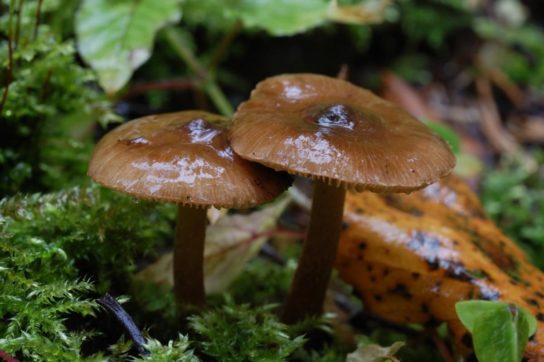
You can meet this representative of Fibers in Eastern Siberia and Europe. Prefers to grow in marshlands or peatlands. An extremely poisonous mushroom.
The cap of the filamentous spine reaches no more than 3.5 centimeters in diameter. It is endowed with a bell-shaped shape, which takes on a flat appearance with the age of the fungus. There is a characteristic tubercle in the center of the cap. The skin color is predominantly brown. The leg varies from 2 to 4 centimeters in height with a width of no more than 0.5 centimeters. The shape is cylindrical. The leg is colored brown with a characteristic mealy bloom. The pulp is white, the shade does not change on the cut.
Fiber Patuillard

A deadly type of fiber. Most common in the Caucasus, as well as in some regions of Europe and Asia. It is found in parks and gardens, as well as in deciduous and mixed forests. It grows, as a rule, on calcareous and clay soils. Can form mycorrhiza with linden and beech.
The appearance of the Patuillard fiber is represented by a cap and a leg. The color of the cap is white, but there are also gray species. Ripe mushrooms change color to red or brown. The diameter of the cap ranges from 3 to 9 centimeters. The shape of young mushrooms is canonical, while mature ones are flat. There is a small tubercle in the center. The texture of the hat is silky. The stem of the mushroom varies from 4 to 10 centimeters in height with a width of no more than 1.5 centimeters. The color is similar to the hat, it differs only in lighter shades. The shape of the leg is cylindrical with a thickening towards the base. The pulp does not have a special smell, but it has a peppery taste. The color of the pulp is white, but on the cut, the color becomes red.
Fiber reddening

This species has spread in many coniferous and deciduous forests. 10 grams of this mushroom is enough to get an extremely dangerous poisoning.
The diameter of the cap varies from 6 to 9 centimeters. The shape is bell-shaped, which then evens out with increasing age of the fungus. There is a characteristic hill in the center. The skin of the cap is colored white, which then takes on a red or yellow tint. The leg reaches a height of up to 7 centimeters with a thickness of 0.5 centimeters. The texture is dense. The color is similar to the hat.
Whitening fiber

Quite a rare species of Fibers, which is found in the pine or coniferous forests of Kazakhstan. It grows, as a rule, in large groups. Poisonous.
The appearance is represented by a head and a leg. A hat with a diameter ranging from 1.5 to 6 centimeters. Conical or convex shape. There is a whitish bump in the center. The leg can reach a height of 3 to 10 centimeters with a thickness of no more than 0.7 centimeters. The shape is cylindrical. The color is white with a pink tint. Covered with a characteristic mealy bloom. The flesh of the mushroom is white with a fragile texture. The taste and smell are pleasant.
Biological description [edit]
Fruit bodies are cap-pedunculated, the cap of adult mushrooms is 2-9 cm in diameter, in young fruiting bodies it is conical, with a turned-up edge, then opens up to bell-shaped and broad-bell-shaped, with a sharp tubercle in the center, often cracking radially. The surface of the cap is radially fibrous, silky, slippery in wet weather, painted in golden yellow, pale straw yellow or honey brown tones, darker in the center.
The plates of the hymenophore adhered to the pedicle to almost free, frequent, with a serrated white edge, whitish in young mushrooms, then grayish-yellowish, with a greenish tinge, in old mushrooms, coffee-brown.
The pulp is whitish, thin, usually without a special smell and taste, less often with an unpleasant odor.
Leg 4-9 (11) cm high and 0.5-1 cm thick, cylindrical, less often slightly tapering towards the base, smooth, longitudinally fibrous, whitish, then colored to match the cap color.
The spore print is brown, the spores are elliptical, pale brown, 10-12 × 6-8 µm.
A poisonous fungus that causes gastrointestinal poisoning.
Description of the fiberglass patuillard
The hat is usually reddish in color. Its diameter is 3-9 centimeters. The shape of the cap is at first bell-cone-shaped, but later it straightens out, while a protruding tubercle remains in the center. The cap is covered with a smooth skin that appears to be very dry. The edges of the cap have deep radial cracks.
The pedunculus stem is the same color as the cap or is slightly lighter in color. Its length is 4-10 centimeters, and its diameter is 0.8-1.5 centimeters. The stem is cylindrical, strong, dense, fibrous, slightly thickened at the base. There are grooves along the entire length of the leg.
The pulp is white, its taste is peppery, and there is practically no smell. If damaged, the flesh turns red, especially for older specimens. The plates are located very often, they are not wide. The color of the plates is pink at first, and later brown with red spots. On the edges of the plate are white with fluff. Spore powder of ocher-brown color or brown. The shape of the spores is bean-shaped or oval, the surface is smooth, the color is brown.
Variability of the fibula patuillard
The color of the cap varies from white to ocher and gray, and in mature mushrooms it can be brick red. If you press on the leg, it turns red. The color of the plates is reddish at first, and then becomes olive brown or rusty brown. The pulp often turns pink.
Distribution and seasonality of patuillard fiber
This type of fiber grows in forests of various types, in gardens, parks. These fungi settle mainly on clay and calcareous soils. They enter into mutually beneficial alliances with beeches and linden trees.
Patouillard fibrils grow in small groups or singly. They mainly choose mountainous and hilly areas. These mushrooms are distributed locally in Europe and certain regions of Asia. They are often found in the European part of Russia, as well as in the Caucasus. They bear fruit from August to September.
Similar species
The May row is outwardly similar to the patuyard fiber, but it differs in that its pulp does not have a red tint, but it smells like flour.
The Godet fiber also looks like a patuillard fiber, but its size is smaller, the base of the leg is swollen, and the flesh does not have a reddish tone. Beginners may confuse the fiber patuyard with some mushrooms.
The toxicity of the fibrous patuillard
- Diarrhea;
- Vomit;
- A sharp drop in blood pressure;
- Tachycardia;
- Difficulty breathing
- Redder than the skin;
- Constriction of the pupils;
- Severe chills.
The victim is given salted water, atropine and glucose. Seeking medical attention is compulsory.
Related species
Bulb fiber is a poisonous mushroom with an umber-brown conical cap, which then becomes flat-spread. Its diameter is 30-60 millimeters.The surface of the cap is bare, but later radial cracks appear on it. The leg is cylindrical, slightly narrowed at the top, up to 80 millimeters high and up to 8 millimeters thick. One-color leg with a cap. The pulp has an unpleasant taste and smell.
Fruiting onion from August to October. These mushrooms grow in deciduous forests. They meet in small groups or singly. They are found under birches, in damp places.
The fiber is similar - a poisonous mushroom. His hat is small - 1-4 centimeters in diameter. Its shape changes from conical to broadly convex. The texture of the cap is fibrous. Its surface is covered with brown or brown-black scales. The flesh is whitish or yellowish in color with an unpleasant odor. The height of the leg reaches 6 centimeters, and the thickness is up to 0.6 centimeters. There is a mealy bloom in the upper part of the leg.
Similar fiber is often found in Europe, North America and Asia. These mushrooms grow singly or in small groups. They settle in mixed and coniferous forests.
Fiber is a poisonous mushroom of the spiderweb family. This mushroom acquired this name because of the fibrous stem. In terms of its toxicity, the fibula exceeds the fly agaric: some of its species contain 20 times more muscarine than the red fly agaric.
These mushrooms, especially when young, are very similar to edible mushrooms. The danger of these mushrooms is compounded by the fact that they grow in the same places as edible mushrooms (champignons, ringed caps). Inexperienced mushroom pickers can also confuse fiberglass with entolomes or the May mushroom (May mushroom).
Broken fiber
Torn fiber - lat Inocybe lacera
It is also called Torn Fiber. She got such names because of the numerous fibrous scales that cover both hats and legs.
Description
Mushroom cap
Torn fiber hats grow small - from 10 to 50 mm in diameter. At first, they are in the shape of a ball, later they turn into convex semi-open umbrellas or open almost completely, keeping a mound in the middle.
The hat surface is speckled with small scales and thin filaments. The edges of young specimens are framed by the remains of a bedspread, the edges of adult mushrooms are exposed and cracked, like the hats themselves. The skin turns pale brown, brownish yellow or brownish brown with a darker center.
The "headdress" is filled with white, slightly yellowing flesh with age. At first, it has a faint odor and a sweetish aftertaste, later it exudes an unpleasant aroma and acquires a bitter taste.
The bottoms of the hats are trimmed with wide plates growing to the legs, at first light, with aging - gray-brown or brown-brown. The edges remain white throughout the life of the fiber.
The torn fiber is propagated by elongated, uneven, tobacco-brown spores that form in a reddish-brown spore powder.
Torn fiber - lat Inocybe lacera
Stipe
The legs of the fibers reach 5-10 mm in thickness and 40-80 mm in height, and have the shape of a straight or slightly curved cylinder that does not have an expansion at the bottom. The leg, completely covered with brownish-red fibrous scales, is filled with reddish pulp. The foot surface is usually reddish, brownish or dark brown in color.
Growing places
Fibers of this species grow in damp deciduous and coniferous forests, inhabited by willow thickets, road shoulders and swampy ravines. They yield from July to October and bear fruit in single specimens or in small families.
Edibility
The pulp of these mushrooms is replete with the content of muscarine toxin: its use leads to severe poisoning and problems with the autonomic nervous system and respiratory organs. At high dosages, people choke or die of cardiac arrest.
The poisonous qualities of the fiber are preserved even after prolonged cooking, and part of the poison passes into the broth. To get to the next world, it is enough to eat 80 grams of such fungi.
Types of fiberglass
Consider the varieties of fiberglass.
Fiber Patuillard
This is the most dangerous type of fiber. Patuillara's hat is 3-9 centimeters in diameter, off-white or greyish, becoming reddish or off-orange over time. At first, its shape is conical, over time it becomes flat, however, a tubercle is expressed in the center. The surface of the hat is glossy, uniform, with a glossy sheen.
The pulp does not have a characteristic mushroom aroma, it tastes like black pepper, white. When pressed, it changes its shade to brick. The leg is 6-10 centimeters, the diameter is up to 1.5 centimeters. The color is the same as the hat. Has a cylinder-like shape.
Torn fiber
This variety stands out for its miniature size - the hat resembles a bell shape, with a diameter of 2 to 5 centimeters. At the top, it is strewn with small scales, covering the entire palette of brown in color. The edging has a non-uniform structure. At the bottom of the cap are discs, whitish at the edges, the rest of the area is brown.
The small cylindrical stem is straight, the texture is scaly, brick-colored. Its flesh has a reddish tint, and the hat is white. The aroma of the pulp is practically not felt, according to the taste characteristics, the torn fiber is at first sweetish, then bitter. Eating is strictly prohibited, as it leads to disastrous consequences. Usually grows in damp forest areas.
Earthen fiber
This type of mushroom is very small - the hat is up to 3 centimeters in diameter. It has a conical shape with a tubercle in the middle. The surface is homogeneous, shiny, fibrous texture. At first, the hat is white, then it acquires a pinkish or lilac hue, sometimes yellow, the edges are cracked.
The leg of the mushroom is 2-5 centimeters long, with a diameter of up to 0.5 centimeters. In young plants, it is dense, becoming hollow over time. The shape of the stem is straight, without changes at the base. The color of the mushroom is white at first, then becomes yellowish or brownish. The pulp of earthen fiber has a slight earthy smell, the texture is fragile, and the taste is unpleasant
This species grows in the European part of the Russian Federation, in the Caucasus, the Far East. Sometimes also found in East Asia, North African and American forests.
Fiber fiber
This type of mushroom is medium in size - a diametrically shaped cap of 5-8 centimeters, a conical shape with an uneven but symmetrical edging, a dirty orange or brownish hue, the surface is strewn with cracks. In the lower part there are serrated plates of brownish or white color. The leg is brownish, straight, thickened at the base, forming a tuber, about 10 centimeters in height, covered with pronounced fibers.
The pulp of fibrous fibrous elastic. At the cap, it has a yellowish tint, at the leg it is brown. In addition to muscarine, this type of mushroom contains another poisonous psychotropic substance - psilocybin. It grows mainly in deciduous and coniferous forest zones.
Fiber bluish green
This is a miniature variety - mushroom caps are no more than 5 centimeters in diameter. The surface is perfectly smooth and glossy. Initially, the shape is conical, in the process of growth it becomes flattened with a pronounced tubercle in the middle. On mature specimens, the edging is cracked. In the lower part there are plates of a brownish shade.
The leg of the bluish-green fibrous is straight, slightly thickened towards the base, covered with a flour-like bloom, the structure is slightly fibrous.
The flesh of the mushroom in a white hat, has a bluish tint in the stem, which is why the look got its name. The smell of the pulp is soapy.It contains a significant amount of psychotropic components, mainly psilocybin.
Types of fiberglass
Fiber is a very common genus of poisonous and hallucinogenic mushrooms. This genus includes about 150 species, of which more than a hundred grows on the territory of Russia. The most common types of it are: Patuyara, torn, earthen, fibrous and bluish-green.
Fiber Patuillard
These are the most poisonous mushrooms of the fibrous genus. They have caps 3-9 cm in diameter. Its shape differs in mushrooms of varying degrees of maturity: in young mushrooms it is conical, in ripe ones it is flat with a tubercle in the center. The reddish cap is smooth, with deep radial cracks along its edge. The plates on the back of the cap are very dense, pink in young specimens, brown in mature specimens with red spots. Spore powder is bright orange in color.
The peduncle of the Patuillard fiber is cylindrical, dense, fibrous, thickened at the base.
The pulp of young mushrooms is white; as it ripens, it turns red. The pulp has no smell, the taste is peppery. It contains a huge amount of poisonous muscarine.
These mushrooms grow in small groups in forests, parks, gardens with clay and limestone soils. Fruiting in August-September.
Torn fiber
This species is distinguished by its small size: their bell-shaped cap has a diameter of 2 to 5 cm. The top of the cap is covered with small scales, painted in different shades of brown, along the edges there is a flaky fringe. On the underside of the cap there are brown-colored plates with a white edge. Spore powder is rusty.
The stem is straight, brown, covered with reddish scales.
The flesh of the cap is white and the flesh of the leg is red. The smell of the pulp is weak, and the taste is first sweet, then bitter. The use of these mushrooms is strictly prohibited, as they are deadly poisonous.
They grow everywhere in damp forests. Fruiting in July-September.
Earthen fiber
These are small poisonous mushrooms. The cap of this type of fiber has a diameter of 2-3 cm, hemispherical, along the edges you can see the remnants of a private veil in the form of a thin cobweb. The surface of the cap is white and has a slight purple tint. The plates on the back of the cap are loose, yellowish.
The stem of the mushroom is thin, silky, brown or brown in color. The pulp has an unpleasant odor. It contains a lot of the neurotoxic poison muscarine.
They grow singly or in small groups, in forests, parks, gardens, hiding in bushes or tall grass. Ripen in July-September.
Fiber fiber
These poisonous mushrooms are medium in size - the diameter of the cap is 6-8 cm. The cap has a conical shape with a wavy edge, dirty yellow or brown in color. Its surface is covered with radial cracks. On the underside of the cap there are white or brown plates with jagged edges.
The pulp is elastic, white-yellow on the cap and brown on the stem. The pulp contains the neurotoxic poison muscarine and the psychotropic substance psilocybin.
The leg is brown, about 10 cm high, covered with fibers. It is thickened at the base and forms a tuber in the ground.
They grow in coniferous and deciduous forests, in meadows with rare herbaceous vegetation. There are only single specimens.
Fiber bluish green
Hats mushrooms of this species do not exceed 4-5 cm in diameter. The surface of the caps is silky, smooth, rusty with a green tint. In young ones, they are conical, flatten during maturation, but a tubercle remains in the center. On the edge of the caps of mature individuals, they crack. On the underside there are gray-brown plates.
The pulp is white, in the lower part of the leg - a green-blue hue, which gave the name to this species. The mushroom smells like toilet soap. It contains many different psychotropic (hallucinogenic) substances, the main of which is psilocybin.
Legs are even, thickened at the base, without earthen tuber, covered in the upper part with a mealy bloom and fibers.
They grow everywhere on soils with a lot of sand, form mycorrhiza with deciduous trees. Often found in parks. Fruiting from June to October.
The bluish-green fiber is a conditionally inedible fungus. Fungi of this species do not cause poisoning similar to poisoning with other types of fiber, however, when they are used, auditory and visual hallucinations, a state of euphoria occur.


